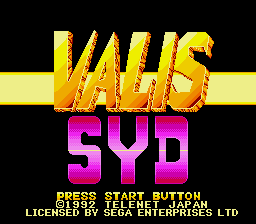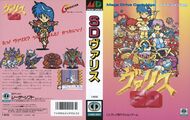Syd of Valis
From Sega Retro
| Syd of Valis | |||||||||||||||
|---|---|---|---|---|---|---|---|---|---|---|---|---|---|---|---|
| System(s): Sega Mega Drive | |||||||||||||||
| Publisher: Laser Soft (JP), Renovation (US) | |||||||||||||||
| Developer: Nihon Telenet, I.S.C. | |||||||||||||||
| Genre: Action | |||||||||||||||
| Number of players: 1 | |||||||||||||||
|
This short article is in need of work. You can help Sega Retro by adding to it.
SD Valis (SDヴァリス) is a remake of Telenet Japan's 1989 MSX/TurboGrafx-16 game Valis II with new "super deformed" graphics released in 1992 for the Sega Mega Drive.
A European release was planned by Ubisoft[3] but it did not materialise.
Contents
Story
The manual features a brief comic (translated rather accurately in the US printing), where Yuko says after defeating Rogles (in Valis) she took the train home and went about her regular life, still carrying the Valis sword around. One afternoon while eating a pudding, Yuko is contacted by the deceased Reiko who insists that Yuko return to Queen Valia immediately.
The game itself has a very simple opening cutscene before the title screen where the evil Megas appears before Yuko while she's eating an ice cream cone and challenges her to come to Vecanti to defeat him. Yuko transforms her ice cream into the Valis sword, and 'the adventure begins'. The game itself opens with no cutscene, jumping straight to Act 1 Level 1 with no fanfare.
Gameplay
Attacking is somewhat different from other Valis games, as this time Valis can be aimed with the D-pad while hitting ![]() to swing (including swinging straight down in mid-air). You can hold
to swing (including swinging straight down in mid-air). You can hold ![]() to repeatedly swing, shooting magic bullets in the process.
to repeatedly swing, shooting magic bullets in the process. ![]() jumps; if not swinging the sword, hitting
jumps; if not swinging the sword, hitting ![]() again double-jumps.
again double-jumps. ![]() crouches.
crouches. ![]() uses screen-clearing bombs, which are limited in quantity but can be restocked by finding rare Sphere icons. There are also 1-UPs, small hearts which heal an imperceptibly tiny amount of health, large hearts which refill the entire life bar, and Score Diamonds worth a meager 300 points. Every 5000 points, the player is awarded a 1-UP, which become very useful as the player cannot continue. Defeating any boss with a life meter will refill Yuko's life meter.
uses screen-clearing bombs, which are limited in quantity but can be restocked by finding rare Sphere icons. There are also 1-UPs, small hearts which heal an imperceptibly tiny amount of health, large hearts which refill the entire life bar, and Score Diamonds worth a meager 300 points. Every 5000 points, the player is awarded a 1-UP, which become very useful as the player cannot continue. Defeating any boss with a life meter will refill Yuko's life meter.
Of note in this game is the weapon/armor system. START opens a menu where you can select weapons and armor acquired from some boss fights. Defeating particular boss-class enemies will give Yuko a sword and/or armor, which she keeps for the rest of the game and can switch at any time. Each weapon has a base attack power (A. Power) which is modified by the armor being used; each Armor has a defense level (D. Power) and a Speed statistic. 10 speed is Yuko's normal speed; it can be raised to 15 (Yellow Armor or Super Armor) or 20 (Speed Suit) at the expense of control especially when jumping, which can be a serious detriment, especially in platforming-intensive areas.
Additionally (and not mentioned in the manual), after beating certain mid- or end-stage bosses, Yuko's health meter will increase by a small amount, until it reaches the maximum just before Act 5 starts.
There are four weapons:
- Normal Beam: a simple ball-shaped projectile is fired straight forward
- Wide Beam: shoots an arrow-shaped blade; slightly more damage than the Normal Beam
- Homing Beam: a star-shaped projectile seeks out near by enemies and damages them; it can sometimes become confused and circle enemies infinitely
- 3-Way Beam: fires a projectile like the Normal Beam but in three directions (forward, up at 45 degrees, and down at 45 degrees)
Each weapon can be powered up to Level 3 over the course of the game. An upgrade increases the damage of each shot, and in some cases the size of the projectile as well. The sword itself seems to do no damage.
There are six suits of armor:
- Normal Suit: a school uniform, and the only armor Yuko has at the beginning of the game
- China Dress: a pink cheongsam; provides slightly higher defense but very slightly lower attack power
- Yellow Armor: Yuko's signature yellow armor; provides higher defense and speed
- Guard Suit: A white suit of armor that improves Yuko's defense substantially at the cost of attack power
- Speed Suit: Blue bikini armor that provides the highest speed in the game
- Super Armor: Magical armor with the highest attack and defense in the game plus a speed boost
(Oddly, the Speed Suit shows a D. Power of 20--second highest of all armor--but it seems to provide less defense than the Yellow Armor's 15 D. Power.)
As in Valis III, dialogue occurs throughout the game. ![]() makes the text load faster and moves to the next line.
makes the text load faster and moves to the next line.
History
Renovation brought it to the US as Syd of Valis; while the box and manual call lead character Yuko, the game changes her name to Syd for whatever reason. The title screen is changed from SD Valis to the equally confusing Valis Syd, presumably a localization error.
As if that weren't enough, the cover features a number of characters who not only do not appear in the game, but are not related to the Valis universe at all with the exception of Yuko front and center. The cover is lifted virtually wholesale from Sugoroku '92 Nari Tore Nariagari Trendy, a board game for the PC Engine CD-ROM by LaserSoft that featured a number of characters from various Telenet properties (Guy Kazama from Last Alert, Yu and Rim from the Cosmic Fantasy series, and Tetsuya from Super Albatross among others). Why this particular cover was chosen is anyone's guess. (As if to add one more scoop of localization shenanigans, the "Game Over" screen isn't translated at all!)
This would be the last Valis release on a Sega system; Telenet Japan ceased all Sega development in 1993 and released Valis IV as a PC Engine/SNES exclusive.
Versions
Localised names
| Language | Localised Name | English Translation |
|---|---|---|
| English (US) | Syd of Valis | Syd of Valis |
| Japanese | SDヴァリス | SD Valis |
Magazine articles
- Main article: Syd of Valis/Magazine articles.
Promotional material
- Main article: Syd of Valis/Promotional material.
Physical scans
| Sega Retro Average | ||||||||||||||||||||||||||||||||||||||||||||||||||||||||||||||||||||||||||||||||||||
|---|---|---|---|---|---|---|---|---|---|---|---|---|---|---|---|---|---|---|---|---|---|---|---|---|---|---|---|---|---|---|---|---|---|---|---|---|---|---|---|---|---|---|---|---|---|---|---|---|---|---|---|---|---|---|---|---|---|---|---|---|---|---|---|---|---|---|---|---|---|---|---|---|---|---|---|---|---|---|---|---|---|---|---|---|
|
| 54 | |
|---|---|
| Based on 16 reviews | |
Technical information
ROM dump status
| System | Hash | Size | Build Date | Source | Comments | |||||||||
|---|---|---|---|---|---|---|---|---|---|---|---|---|---|---|
| ✔ |
|
512kB | 1992 | Cartridge (US) | ||||||||||
| ✔ |
|
512kB | 1992 | Cartridge (JP) |
References
- ↑ File:SegaVisions US 08.pdf, page 58
- ↑ 2.0 2.1 2.2 File:GamePro US 037.pdf, page 42 Cite error: Invalid
<ref>tag; name ":File:GamePro US 037.pdf_p42" defined multiple times with different content - ↑ Sega Force, "January 1992" (UK; 1991-12-12), page 10
- ↑ File:BeepMD_JP_1992-03.pdf, page 37
- ↑ File:SSM_JP_19950901_1995-09.pdf, page 87
- ↑ 6.0 6.1 File:SegaPro UK 06.pdf, page 38 Cite error: Invalid
<ref>tag; name ":File:SegaPro UK 06.pdf_p38" defined multiple times with different content - ↑ 1700 igr dlya Sega, "" (RU; 2001-xx-xx), page 233
- ↑ Beep! MegaDrive, "March 1992" (JP; 1992-02-08), page 37
- ↑ Consoles +, "Avril 1992" (FR; 1992-0x-xx), page 80
- ↑ Console XS, "June/July 1992" (UK; 1992-04-23), page 133
- ↑ Famitsu, "1992-03-06" (JP; 1992-02-21), page 37
- ↑ Games-X, "27th February-4th March 1992" (UK; 1992-02-27), page 26
- ↑ Hippon Super, "March 1992" (JP; 1992-02-04), page 83
- ↑ Joypad, "Avril 1992" (FR; 1992-03-1x), page 78
- ↑ Joystick, "Avril 1992" (FR; 1992-0x-xx), page 120
- ↑ Mega Drive Fan, "May 1992" (JP; 1992-04-xx), page 115
- ↑ MegaTech, "April 1992" (UK; 1992-03-20), page 24
- ↑ Sega Pro, "April 1993" (UK; 1993-03-11), page 67
- ↑ Sega Saturn Magazine, "September 1995" (JP; 1995-08-08), page 87
- ↑ Video Games, "6/92" (DE; 1992-05-29), page 46
NEC Retro has more information related to Valis II
|
- Pages with reference errors
- 1 player games
- JP Mega Drive games
- All JP games
- US Mega Drive games
- All US games
- Mega Drive games
- 1992 Mega Drive games
- All 1992 games
- Mega Drive action games
- All action games
- All games
- Stubs
- Old-style rating (bemega)
- Use magref
- Old-style rating (bemega r)
- Old-style rating (consolesplus)
- Rating without PDF source
- Old-style rating (famitsu)
- External rating reference
- Old-style rating (gamepro)
- Old-style rating (gamesx)
- Old-style rating (hippons)
- Old-style rating (joypad)
- Old-style rating (joystick)
- Old-style rating (megatech)
- Old-style rating (segapro)
- Update ratings template
- 13 old ratings
- Missing ROM hashes
- Missing ROM dumps
- Old technical information



